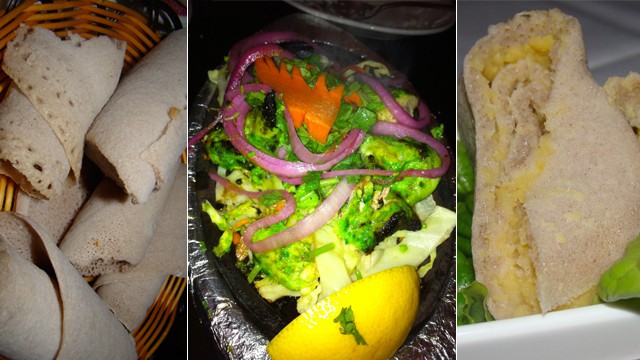Cuisines that are missing in Mississauga
Published July 23, 2012 at 1:20 pm

When it comes to food, Mississauga boasts fairly exceptional variety. In a city rich in ethnic diversity, unique restos are bound to pop up — and pop up they do. It’s impossible to walk down Hurontario and not notice dozens of Japanese, Chinese and Indian restaurants. Most ‘Saugans are more than familiar with savory maki rolls and spicy samosas, and given the relatively recent emergence of food as a passion and dining as an experience, there’s no doubt city dwellers would be open to welcoming more cuisines. So, in the spirit of exotic dining, let’s count down three cuisines Sauga needs.![]()
3) Peruvian
Sauga isn’t lacking in Latin restaurants. If a diner has a hankering for an empanada or paella, he or she can find it. What he or she can’t find, however, is a simple, classic Peruvian restaurant. In fact, the nearest one, Machu Picchu (http://www.machupicchucuisineofoakville.com/contactus.html) is located in Oakville, and the best ones – El Plebeyo and El Fogon — are in Toronto.
Peruvian cuisine boasts the increasingly popular ceviche, a savory dish featuring fish marinated in lemon juice, onion and spices served with potatoes or other vegetables. Diners can also start their meal with flavourful anticuchos — golf-ball sized veal hearts (and no, eating heart isn’t particularly weird if you consider that it would otherwise end up in a garbage disposal somewhere) on metal skewers. The meat is surprisingly tender and delightfully salty. Also recommended are the yuka (imagine a really good, thick, crunchy French fry), and Papa a la Huancaina, a lightly spiced, cheesy potato dish. Peruvian entrees are a little more familiar to the Canadian palate, boasting such non-exotic staples as chicken, fish, veal and beef. What sets those dishes apart is the spicing and marinating. If you’re feeling adventurous, try a whole grilled bass (complete with eyes, fins and a tail). It’s an adventure — those razor sharp bones are a choking hazard — and ultimately satisfying.![]()
2) Nepalese
Nepal, perhaps by virtue of being India’s neighbour, boasts much of the same curried cuisine, so a visit to a Nepali restaurant won’t be too jarring to anyone who’s visited Bombay Bhel. But while diners might be happy to know they can indulge in butter chicken and channa masala, they should also be willing to take the plunge and try some Aloo Tama Bodi (a mountain dish comprised of potatoes, bamboo shoots, beans and Nepali spices) and Khasi Ko Maasu (bone-in goat cooked with Nepali spices).
Since Nepalese food isn’t terribly different from Indian food — and Sauga loves its Indian restos — it should be a hit in the City Centre and beyond. For any Saugans who want to give it a try before they, who knows, open a Nepali restaurant themselves (hint for any entrepreneurial foodies out there), they can venture into Toronto’s Annex neighbourhood and try Mt. Everest. There, they can sample a truly stunning — visually and taste-wise — dish called Hariyali chicken. It’s tender, it’s savory, and it’s bright green (thanks to the mint marinade).
If you ask anyone off the street, he or she is almost certain to agree that if Mississauga is missing anything special, it’s bright green boneless, skinless chicken. And they would be correct.![]()
1) Ethiopian
Ethiopian food has yet to have a true sushi-esque renaissance, which is a shame because it deserves one. Popular in urban areas, Ethiopian cuisine speaks to the experience aspect of dining like no other food. It’s food you share with your companions and linger over for some time (so don’t go to an Ethiopian resto if you have a movie to catch in an hour).
Many of the main dishes — the kitfo (uncooked or cooked spiced beef), tibs (spiced bits of bite-sized meat), miser wot (lentils), kik wot (yellow split peas cooked in red pepper sauce), kik alicha (yellow split peas cooked with ginger, garlic, turmeric, onion and spices) — are served puree-style on a giant whole-wheat pancake called injera. Diners are given a basket of smaller injera to use to pick the food up (no utensils allowed!).
What’s also attractive about Ethiopian cuisine is the restaurant atmosphere. Most, including such T.O. gems as Ethiopian House, Nazareth, Sheba and Addis Ababa, display African art and sculptures and use earth-tones mixed with deep reds and greens to accentuate the exotic nature of the dining experience. Eating out feels a little like going on safari (minus live animals, protective gear, bugs and buggies). An extra-special treat is the pungent aroma of Ethiopian coffee. It’s a smell that screams, “I’m in an African restaurant and I’m going to have pancakes for dinner!”
An Ethiopian resto would be a supremely hip, unique addition to the Lakeshore strip along Port Credit. The perfect meal before a night of artisanal cocktails at West 50 or Ten. ![]()
Let us know what other cuisines are missing in Mississauga.
insauga's Editorial Standards and Policies advertising






